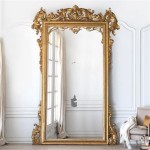Antique Mission Oak Buffet With Mirror: A Timeless Statement of Craftsmanship
The antique Mission Oak buffet with mirror represents a significant chapter in American furniture history. Emerging from the Arts and Crafts movement of the late 19th and early 20th centuries, these pieces embody a philosophy that prioritized simplicity, functionality, and the honest expression of materials and construction. Characterized by clean lines, robust construction, and a focus on showcasing the natural beauty of oak, the Mission Oak buffet with mirror is more than just a piece of furniture; it is a reflection of a bygone era, a testament to enduring design principles, and a valuable antique for collectors and homeowners alike.
The Arts and Crafts movement was a reaction against the mass-produced, ornate, and often poorly constructed furniture that dominated the Victorian era. Proponents of the movement sought to revive traditional craftsmanship, emphasizing handwork and the use of natural materials. This philosophy translated into furniture designs that were straightforward, functional, and aesthetically pleasing in their simplicity. The Mission style, also known as Craftsman style, was an American interpretation of the Arts and Crafts movement, and the Mission Oak buffet with mirror became a quintessential example of this style.
These buffets were designed for the dining room, providing ample storage for dishes, silverware, and serving pieces. The mirror, typically a large, rectangular or arched piece, served not only a practical purpose but also enhanced the light and spaciousness of the room. The combination of practicality and aesthetic appeal made the Mission Oak buffet with mirror a highly desirable item for middle-class households during the early 20th century.
Key Characteristics of Mission Oak Buffets With Mirrors
Several defining characteristics distinguish antique Mission Oak buffets with mirrors from other antique furniture styles. Understanding these features is crucial for identifying authentic pieces and appreciating their historical significance.
Material and Construction: The primary material used in the construction of Mission Oak buffets is, as the name suggests, oak. Oak was chosen for its strength, durability, and distinctive grain pattern. Quartersawn oak, in particular, was highly prized for its beautiful ray flecks and increased stability. The construction methods employed were typically robust, featuring mortise-and-tenon joinery, dovetail drawers, and solid wood panels. Mass production techniques were incorporated to make the furniture affordable, but the emphasis remained on quality craftsmanship.
Design and Aesthetics: The design of Mission Oak buffets is characterized by clean, straight lines, minimal ornamentation, and a focus on functionality. Surfaces are typically flat, with a matte or low-sheen finish that highlights the natural grain of the oak. Hardware, such as drawer pulls and hinges, is often made of copper or brass and features simple, functional designs. The mirror is usually framed in oak and is typically rectangular or arched in shape. The overall aesthetic is one of understated elegance and timeless appeal.
Functionality and Practicality: Mission Oak buffets were designed to be highly functional. They typically feature a combination of drawers, cabinets, and shelves, providing ample storage for various dining room necessities. The mirror serves both a decorative and practical purpose, enhancing the light and spaciousness of the room while also providing a convenient place to check one's appearance. The sturdy construction ensures that these buffets can withstand daily use for generations.
Notable Manufacturers and Designers
Several manufacturers and designers played a significant role in the popularity and widespread adoption of Mission Oak furniture, including buffets with mirrors. Identifying these key figures can aid in attributing and valuing antique pieces.
Gustav Stickley: Gustav Stickley is perhaps the most iconic figure associated with the American Arts and Crafts movement. His company, Craftsman Workshops, produced high-quality Mission Oak furniture known for its simple designs, robust construction, and emphasis on functionality. Stickley's furniture often bears his signature mark, which can significantly increase its value.
L. & J.G. Stickley: Leopold and John George Stickley, brothers of Gustav, also established their own furniture company, L. & J.G. Stickley, which produced a wide range of Mission Oak furniture. Their pieces are often similar in style to those of Gustav Stickley but can be identified by their unique marks.
Charles Limbert: Charles Limbert was another prominent figure in the Mission style. His furniture is known for its distinctive designs, which often incorporate cutouts and geometric patterns. Limbert's pieces are highly sought after by collectors.
Other Manufacturers: Numerous other manufacturers produced Mission Oak furniture, including companies like Roycroft, Lifetime Furniture, and Tobey Furniture Company. While these companies may not be as well-known as Stickley and Limbert, their pieces can still be valuable and historically significant.
Identifying Authentic Antique Mission Oak Buffets With Mirrors
Determining the authenticity of an antique Mission Oak buffet with mirror requires careful examination and attention to detail. Several factors can help distinguish genuine pieces from reproductions or later imitations.
Construction Techniques: Authentic Mission Oak buffets will typically exhibit traditional construction techniques, such as mortise-and-tenon joinery, dovetail drawers, and solid wood panels. The quality of the construction is a key indicator of authenticity. Look for tight joints, well-fitted drawers, and a generally solid feel.
Wood and Finish: The type of wood used and the finish applied can also provide clues about authenticity. Authentic pieces will typically be made of oak, often quartersawn oak. The finish is usually a matte or low-sheen finish that highlights the natural grain of the wood. Be wary of pieces with a high-gloss finish or a finish that appears overly new or artificial.
Hardware: The hardware, such as drawer pulls and hinges, should be appropriate for the period. Original hardware is often made of copper or brass and features simple, functional designs. Be wary of pieces with modern or reproduction hardware.
Marks and Labels: The presence of a manufacturer's mark or label is a strong indication of authenticity. Look for marks from well-known manufacturers such as Gustav Stickley, L. & J.G. Stickley, or Charles Limbert. However, the absence of a mark does not necessarily mean that a piece is not authentic, as many smaller manufacturers did not consistently mark their furniture. Researching known marks and labels is crucial for accurate identification.
Overall Condition: While some wear and tear is to be expected in an antique piece, the overall condition of the buffet can affect its value and authenticity. Look for signs of authentic aging, such as minor scratches, dings, and fading of the finish. However, be wary of pieces that appear overly distressed or have been heavily refinished, as this can diminish their value.
The Value and Collectibility of Mission Oak Buffets With Mirrors
The value of an antique Mission Oak buffet with mirror depends on several factors, including its condition, maker, design, and rarity. Pieces in excellent condition, made by well-known manufacturers, and featuring unique or rare designs will typically command the highest prices.
Condition: The condition of the buffet is a primary determinant of its value. Pieces in excellent condition, with minimal wear and tear and an original finish, are generally more valuable than those in poor condition or with significant damage.
Maker: Pieces made by well-known manufacturers, such as Gustav Stickley or Charles Limbert, are typically more valuable than those made by lesser-known manufacturers or those that are unmarked.
Design: Unique or rare designs can also increase the value of a Mission Oak buffet. Pieces with unusual features, such as elaborate carvings or distinctive hardware, may be more desirable to collectors.
Rarity: The rarity of a particular piece can also affect its value. Pieces that are difficult to find or that were produced in limited quantities are generally more valuable.
The collectibility of Mission Oak furniture, including buffets with mirrors, has fluctuated over the years. However, these pieces remain highly sought after by collectors and homeowners who appreciate their timeless design, robust construction, and historical significance. The enduring appeal of Mission Oak furniture ensures that these pieces will continue to be valued for generations to come.
Mission Oak buffets with mirrors are not only valuable antiques but also functional pieces of furniture that can enhance the beauty and character of any home. Their simple elegance, robust construction, and historical significance make them a timeless investment for collectors and homeowners alike.

Mission Buffet Cabinet With Mirror Dark 50 Crafters And Weavers

Antique Mission Oak Arts And Crafts Sideboard Buffet 66w22d38h55h Is Not Free

Mission Buffet Cabinet With Mirror Michael S Cherry 50 Crafters And Weavers

Antique Arts Crafts Mission Oak Sideboard Buffet With Mirror Gallery

Arts Crafts Mission Oak Antique Sideboard Buffet Mirror
Mission Buffet Cabinet With Mirror Dark 50 Crafters And Weavers

Arts And Crafts Mission Style Mirrored Buffet Console Cabinet

Early 20th Century Antique Arts Crafts Mission Oak Sideboard Buffet With Mirrored Gallery Chairish

Vintage Stickley Brothers Mission Oak Sideboard With Mirror Lot 314 The Mid Summer Estate Auctionjul 30 2024 10 00am
Mission Oak Furniture C3675a Adobe Gallery Santa Fe








